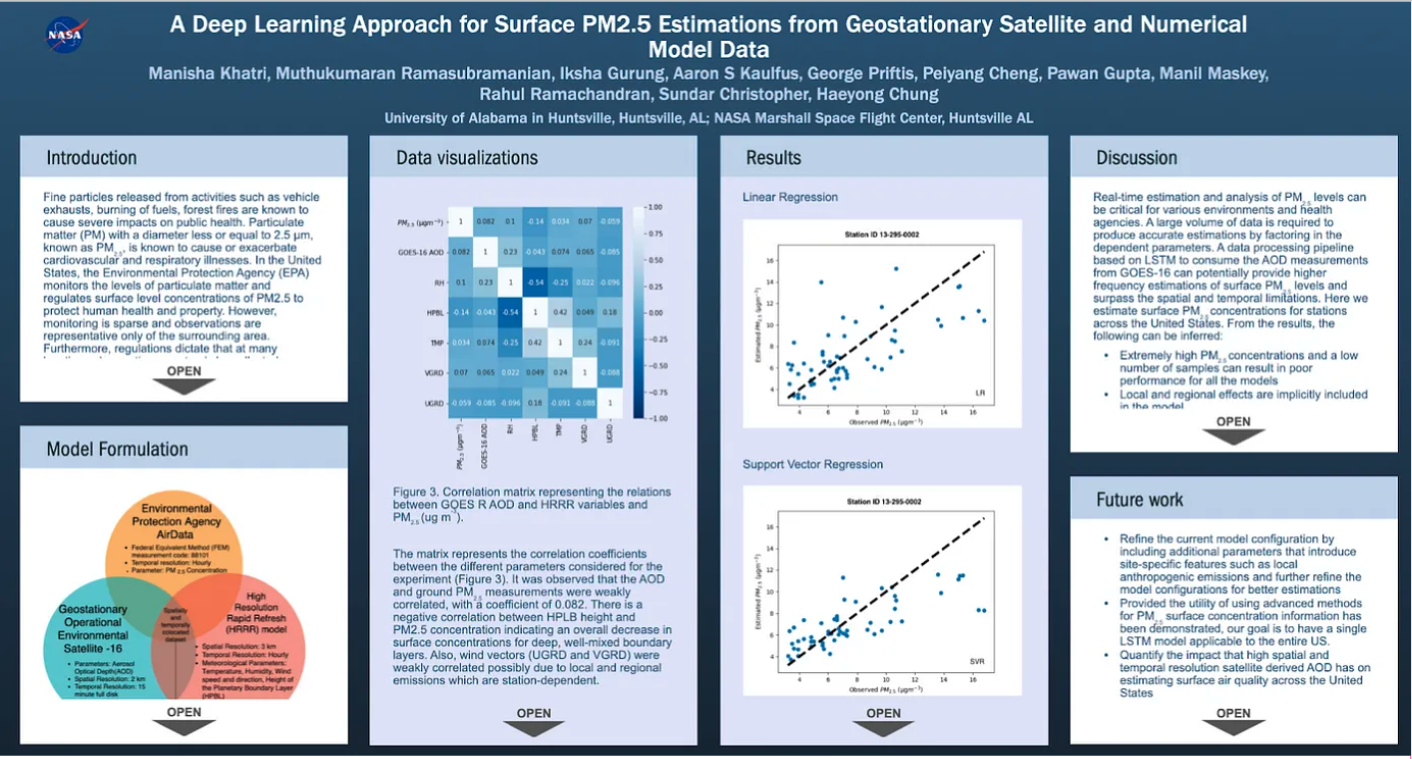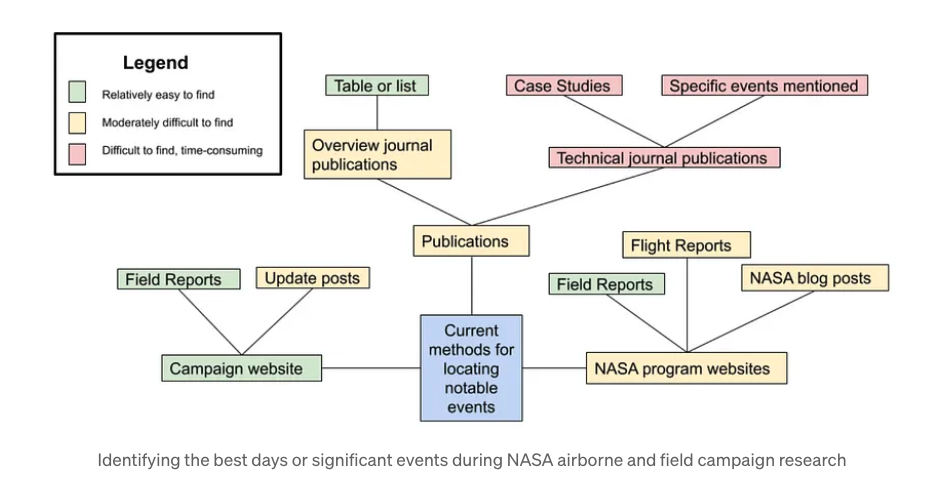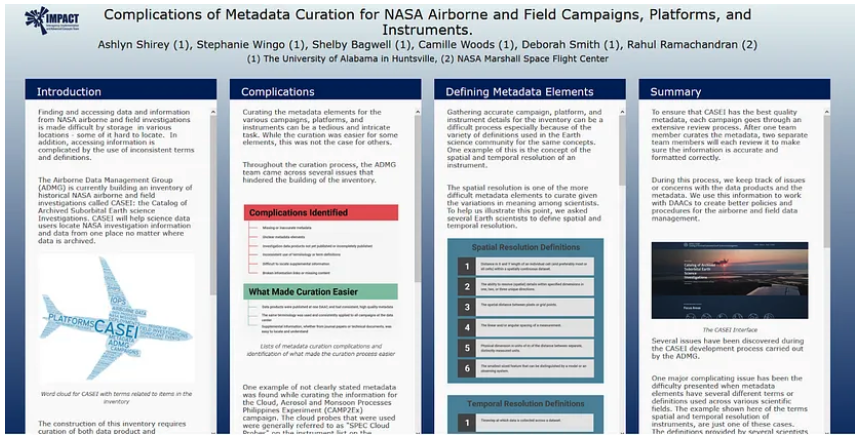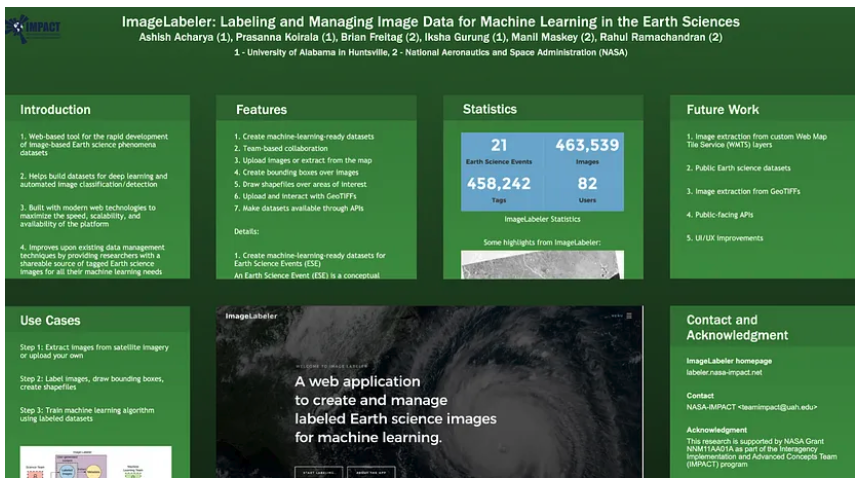This year’s AGU Fall meeting has ended. Earlier we posted about a group of high school students who presented their research at AGU in partnership with an IMPACT team member. This is not the only way in which IMPACT supports student scientists at AGU. Four IMPACT team members who are graduate research assistants or undergraduate interns at the University of Alabama in Huntsville also had the opportunity to present research at AGU.
Graduate research assistant Manisha Khatri presented a deep learning approach to estimating surface PM2.5 levels. This research uses satellite and meteorological data and applies deep learning methods to predict levels of the aerosol pollutant PM2.5. Ms. Khatri believes this approach will help surpass spatial and temporal limitations of ground-based measurement techniques. Working with the IMPACT machine learning team on this project is the first intensive research work with which Ms. Khatri has been involved. What's more, she felt presenting at AGU to be a very rewarding experience:
"Having participated in AGU, helped align our work and quantify our results. It was a milestone achieved. The various sessions gave me an insight into the different domains and guided me to direct my research in a more application-oriented manner."
IMPACT undergraduate intern Shelby Bagwell made her debut at AGU with a presentation on the "best days" of NASA research campaigns and their accessibility to scientists. Identifying these best days — defined as those containing notable events that highly relate to the objective of the campaign or when all instruments operated and cross comparison of measurements are possible — is currently a time-consuming and sometimes difficult task for past campaigns. Ms. Bagwell’s presentation discussed how IMPACT's Airborne Data Management Group (ADMG) is addressing this issue through a Catalogue of Archived Suborbital Earth Science Investigations by providing scientists with lists of these notable events and the context surrounding them.
Ms. Bagwell felt being able to present at AGU as an undergraduate student was an amazing opportunity and helped her continue to build confidence in herself as a scientist.
"I have been exploring different areas of Earth science that I am interested in pursuing both for graduate school and in my future career. Being able to attend AGU has been a wonderful way for me to look into these different topics. Being able to listen to experts present their work has been fascinating, and it has been invaluable."
Graduate research assistant Ashlyn Shirey delivered a presentation that demonstrated the complications involved in the curation of the metadata for NASA airborne and field campaigns, platforms, and instruments. Ms. Shirey is also part of the IMPACT ADMG team that is building an inventory of historical NASA airborne and field campaigns and curating detailed metadata elements about the campaigns as well as the platforms and instruments used. This effort has discovered several issues with existing metadata that has hindered the curation process.
One of the main issues Ms. Shirey presented was the use of various definitions for the same terms within the scientific communities with airborne and field campaigns. As an example, the spatial and temporal resolution of the instruments was one of the more difficult elements to curate due to various definitions among scientists. Setting formalized definitions and using an information model to build the inventory allows for the information and metadata to be more consistent across all campaigns and enables more efficient data access and discovery.
Ms. Shirey found a valuable aspect of her AGU experience was having the opportunity to attend talks and presentations related to her master’s thesis on COVID-19 and its effects on local climate and weather. The available literature on this research topic is limited; attending AGU allowed her to learn about other scientists’ research first hand and gain perspective on where research needs to go in order to determine how much of an impact COVID-19 will have on climate change.
"The main thing that I got from my experience that will help me as a researcher is that I am not only answering my intended research question, but I am also still asking questions to help further develop that research topic. There is always more we can learn about a certain topic, so asking questions and trying to develop new methods is just as important to the research process as the actual work itself."
Mr. Prasanna Koirala, a graduate research assistant on IMPACT’s machine learning team, presented an application named ImageLabeler, which bridges the gap between the lack of labeled Earth science datasets and the requirements of machine learning. ImageLabeler allows users to create, manage and label Earth science datasets such that they can directly be fed to a machine learning algorithm for training.
Mr. Koirala found that the presentation experience helped him to develop important skills necessary for research. He describes preparing for the presentation as challenging, exciting, and that the process involved numerous iterations and feedback.
"AGU being a global platform definitely raised the stakes as high as I had ever experienced. This made me become more careful about what I put in the presentation, as well as what I delivered when I was actually presenting."
The experiences of these team members demonstrate IMPACT's commitment to not only advancing Earth science research through the application of computer science and informatics, but also by doing our part to nurture and develop the next generation of Earth and computer scientists. More information about IMPACT and these projects can be found here on NASA Earthdata and the IMPACT project website.




